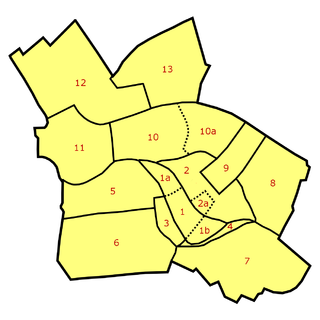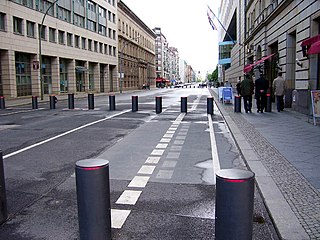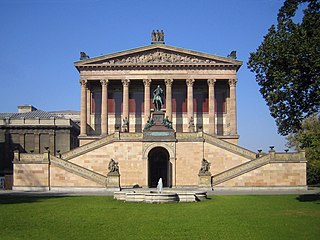History
The Alte Kommandantur is a building in the historic center of Berlin, which had been heavily damaged during World War II and destroyed in order to make room for the Ministry for Foreign Affairs of East Germany.
The original building was in the baroque style, built by architect Johann Gregor Memhardt (b. 1607, d. 1678), and enlarged in 1795, and modified again in 1873 in a neo-Renaissance style.
In 1995, the Ministry for Foreign Affairs of East Germany itself was demolished in order to recreate the Werderscher Markt area.
The Alte Kommandantur was rebuilt by media conglomerate Bertelsmann and the Bertelsmann Stiftung foundation to become its joint Berlin liaison office with the prestigious address Unter den Linden 1. Since no plan was available, the building was designed based on historic pre-war photographs and testimonies. The building was completed in November 2003.

The Museum Island is a museum complex on the northern part of Spree Island in the historic heart of Berlin, Germany. It is one of the capital's most visited sights and one of the most important museum sites in Europe. Originally built from 1830 to 1930, initially by order of the Prussian Kings, according to plans by five architects, the Museum Island was designated a UNESCO World Heritage Site in 1999 because of its testimony to the architectural and cultural development of museums in the 19th and 20th centuries. It consists of the Altes Museum, the Neues Museum, the Alte Nationalgalerie, the Bode-Museum and the Pergamonmuseum. As the Museum Island designation includes all of Spree Island north of the Karl Liebknecht Boulevard, the historic Berlin Cathedral is also located there, next to the open Lustgarten park. To the south of Liebknecht Boulevard, the reconstructed Berlin Palace houses the Humboldt Forum museum and opened in 2020. Also adjacent, across the west branch of the Spree is the German Historical Museum. Since German reunification, the Museum Island has been rebuilt and extended according to a master plan. In 2019, a new visitor center and art gallery, the James Simon Gallery, was opened within the Museum Island heritage site.

Unter den Linden is a boulevard in the central Mitte district of Berlin, Germany. Running from the Berlin Palace to the Brandenburg Gate, it is named after the linden trees that line the grassed pedestrian mall on the median and the two broad carriageways. The avenue links numerous Berlin sights, landmarks and rivers for sightseeing.

The Staatsoper Unter den Linden, also known as the Berlin State Opera, is a listed building on Unter den Linden boulevard in the historic center of Berlin, Germany. The opera house was built by order of Prussian king Frederick the Great from 1741 to 1743 according to plans by Georg Wenzeslaus von Knobelsdorff in the Palladian style. Damaged during the Allied bombing in World War II, the former Royal Prussian Opera House was rebuilt from 1951 to 1955 as part of the Forum Fridericianum square. Nicknamed Lindenoper in Berlin, it is "the world´s oldest state opera" and "the first theater anywhere to be, by itself, a prominent, freestanding monumental building in a city."

Friedrichstraße is a major culture and shopping street in central Berlin, forming the core of the Friedrichstadt neighborhood and giving the name to Berlin Friedrichstraße station. It runs from the northern part of the old Mitte district to the Hallesches Tor in the district of Kreuzberg.

Cölln was the twin city of Old Berlin (Alt-Berlin) from the 13th century to the 18th century. Cölln was located on the Fisher Island section of Spree Island, opposite Altberlin on the western bank of the River Spree, until the cities were merged by Frederick I of Prussia to form Berlin in 1710. Today, the former site of Cölln is the historic core of the modern Mitte locality of the Berlin-Mitte borough in central Berlin.

The Zeughaus is a listed building and the oldest structure on Unter den Linden boulevard in the historic centre of Berlin. Erected from 1695 to 1706 according to plans by Johann Arnold Nering, Martin Grünberg, Andreas Schlüter and Jean de Bodt in Baroque style, it was later converted into a Prussian Hall of Fame. Damaged during the Allied bombing in World War II, it was rebuilt from 1949 to 1967 as part of the Forum Fridericianum. Since 2003, it has been home to the Deutsches Historisches Museum. Since June 2021 it is closed for necessary renovations and for the renewal of the Permanent Exhibition probably until the end of 2025.

The Kroll Opera House in Berlin, Germany, was in the Tiergarten district on the western edge of the Königsplatz square, facing the Reichstag building. It was built in 1844 as an entertainment venue for the restaurant owner Joseph Kroll, and redeveloped as an opera house in 1851. It also served as the assembly hall of the Reichstag from 1933 to 1942. Severely damaged by the bombing of Berlin in World War II and the Battle of Berlin, it was demolished in 1951.

Wilhelmstrasse is a major thoroughfare in the central Mitte and Kreuzberg districts of Berlin, Germany. Until 1945, it was recognised as the centre of the government, first of the Kingdom of Prussia, later of the unified German Reich, housing in particular the Reich Chancellery and the Foreign Office. The street's name was thus also frequently used as a metonym for overall German governmental administration: much as the term "Whitehall" is often used to signify the British governmental administration as a whole. In English, "the Wilhelmstrasse" usually referred to the German Foreign Office.

The Hotel Adlon Kempinski Berlin is a luxury hotel in Berlin, Germany. It is on Unter den Linden, the main boulevard in the central Mitte district, at the corner with Pariser Platz, directly opposite the Brandenburg Gate.

The Alte Nationalgalerie is a listed building on the Museum Island in the historic centre of Berlin, Germany. The gallery was built from 1862 to 1876 by the order of King Frederick William IV of Prussia according to plans by Friedrich August Stüler and Johann Heinrich Strack in Neoclassical and Renaissance Revival styles. The building's outside stair features a memorial to Frederick William IV. Currently, the Alte Nationalgalerie is home to paintings and sculptures of the 19th century and hosts a variety of tourist buses daily. As part of the Museum Island complex, the gallery was inscribed on the UNESCO World Heritage List in 1999 for its outstanding architecture and its testimony to the development of museums and galleries as a cultural phenomenon in the late 19th century.

The Bauakademie in Berlin, Germany, was a higher education institution for the art of building to train master builders. Founded on 18 March 1799 by King Frederick William III, the institution originated from the construction department of the Academy of Fine Arts and Mechanical Sciences, which emphasized the aesthetic elements of the art of building while ignoring the technical. Thus, the governmental Upper Building Department ("UBD") decided to establish an entirely new building educational institution named "Bauakademie". In 1801, the institution was incorporated into the UBD.

Karl-Liebknecht-Straße is a major street in the central Mitte district of the German capital Berlin. It is named after Karl Liebknecht (1871–1919), one of the founders of the Communist Party of Germany. The street connects the Unter den Linden boulevard with the Prenzlauer Allee arterial road leading to the northern city limits. Although part of the street dates back to medieval times, most of the buildings at its side were built in the 1960s, when East Berlin's centre was redesigned as the capital of East Germany.

Mitte is a central section of Berlin, Germany, in the eponymous borough of Mitte. Until 2001, it was itself an autonomous district.

is a historic zone or neighbourhood (Stadtviertel) of central Berlin, Germany, which forms part of the locality (Ortsteil) of Mitte within the borough (Bezirk) also called Mitte. It contains several famous Berlin landmarks: the Brandenburg Gate, the Pariser Platz, and Unter den Linden.

Mühlendamm is a major thoroughfare in the central Mitte district of Berlin, Germany. It runs from the historic Cölln and Fischerinsel quarters to the Molkenmarkt square of Alt-Berlin via the Mühlendammbrücke crossing the Spree river. Named after several watermills at the site, a historic causeway was first laid out at this location about 1200 and became the nucleus of the late medieval city foundation. The current prestressed concrete bridge was built in 1968. It is part of an east–west road link to Berlin's city centre and the Bundesstraße 1 highway.

The Kronprinzenpalais is a former Royal Prussian residence on Unter den Linden boulevard in the historic centre of Berlin. It was built in 1663 and renovated in 1857 according to plans by Heinrich Strack in Neoclassical style. From 1919 to 1937, it was home to the modern art collection of the National Gallery. Damaged during the Allied bombing in World War II, the Kronprinzenpalais was rebuilt from 1968 to 1970 by Richard Paulick as part of the Forum Fridericianum. In 1990, the German Reunification Treaty was signed in the listed building. Since then, it has been used for events and exhibitions.

Richard Lucae was a German architect and from 1873 director of the Berliner Bauakademie.

The Old Palace, also called Kaiser Wilhelm Palace (Kaiser-Wilhelm-Palais), is a former royal Prussian residence on Unter den Linden boulevard in Mitte, the historic heart and city center of Berlin. It was built between 1834 and 1837 by order of Prince William of Prussia, who later became William I, German Emperor, according to plans by Carl Ferdinand Langhans in Neoclassical style. Damaged during the Allied bombing in World War II, the Old Palace was rebuilt from 1963 to 1964 as part of the Forum Fridericianum. Since then, the listed building has been home to the law faculty of the Humboldt-Universität.

The Prinzessinnenpalais is a former Royal Prussian residence on Unter den Linden boulevard in the historic centre of Berlin. It was built in 1733 according to plans by Friedrich Wilhelm Diterichs in Rococo style and extended from 1810 to 1811 by Heinrich Gentz in Neoclassical style. Damaged during the Allied bombing in World War II, the Prinzessinnenpalais was rebuilt from 1963 to 1964 by Richard Paulick as part of the Forum Fridericianum. Since 2018, it has been home to an art collection of Deutsche Bank.


















